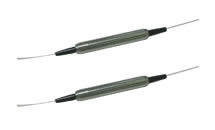PM Fiber products

Click here for all PM Fiber products
What is Polarization Maintaining Fiber?
Polarization Maintaining (also known as PM) Fiber is a specialized type of single-mode optical fiber designed to preserve the polarization state of light as it travels through the fiber. Unlike standard single-mode fibers, which allow light to propagate in multiple polarization modes, PM fibers ensure that the light maintains its polarization characteristics. This is crucial for applications where the integrity of the light's polarization is essential, such as in telecommunications, sensors, and various scientific applications.
The Importance of Polarization
Polarization refers to the orientation of the light wave's electric field. In optical fibers, maintaining the polarization state is vital for the performance of many systems, particularly those that rely on coherent light sources, such as lasers. When light is launched into a standard single-mode fiber, it can split into two orthogonal polarization modes that travel at the same speed, leading to potential cross-coupling and loss of polarization. PM fibers address this issue by ensuring that these modes travel at different velocities, thus preserving the polarization state.
How PM Fiber Works
PM fibers are engineered to create a difference in propagation constants between the two orthogonal polarization modes. This is achieved through various design techniques, such as introducing stress or modifying the fiber's geometry. For instance, the core of a PM fiber can be made elliptical, or controlled stress can be applied to the fiber. This design creates a scenario where light traveling along one axis experiences a different velocity than light traveling along the other axis, making it difficult for light to cross-couple between the two modes.
Types of Polarization Maintaining Fibers
There are several designs of PM fibers, each with unique characteristics and applications. The most common types include Panda fibers, Bowtie fibers, and elliptical core fibers. Panda fibers, developed in the 1980s, are widely used in telecommunications due to their low attenuation and compatibility with standard single-mode fibers. Bowtie fibers, while primarily used in sensor applications, feature a highly elliptical core that enhances polarization maintenance. Understanding these types helps in selecting the right fiber for specific applications.
Click here for all PM Fiber products
Applications in Telecommunications
In telecommunications, PM fibers play a crucial role in systems that require high precision and reliability. They are used in fiber optic gyroscopes, which are essential for navigation and positioning systems, as well as in coherent communication systems where maintaining the polarization state of the light is critical for data integrity. The ability to preserve polarization allows for improved signal quality and reduced errors in data transmission.
PM Fiber in Sensor Technology
Beyond telecommunications, PM fibers are extensively used in sensor technology. Their ability to maintain polarization makes them ideal for applications such as strain and temperature sensing. For instance, fiber optic sensors can detect changes in the environment by measuring variations in the polarization state of light as it interacts with the surrounding medium. This capability allows for highly sensitive and accurate measurements, making PM fibers invaluable in industrial and scientific applications.
Challenges and Limitations
While PM fibers offer significant advantages, they also come with challenges. One of the primary limitations is their sensitivity to external perturbations, such as temperature changes and mechanical stress, which can affect the polarization state. Additionally, the manufacturing process for PM fibers can be more complex and costly compared to standard fibers. Understanding these challenges is essential for engineers and technicians working with PM fibers to ensure optimal performance.
Future Trends
As technology continues to advance, the demand for high-performance PM fibers is expected to grow. Innovations in fiber design, materials, and manufacturing processes are likely to enhance the capabilities of PM fibers, making them even more effective in various applications. Research is ongoing to develop fibers that can maintain polarization over longer distances and under more challenging conditions, which could open new avenues for their use in emerging technologies.
Optosun PM product features include:
Wide bandwidth, 780nm to 1550nm wavelength ranges, and also C and L band.
High return loss, high extinction ratio, high isolation.
Low insertion loss over the entire range.
High reliability and environmental stability.
All PM Fiber Products

